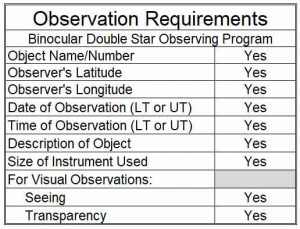Appendix C: Rules and Requirements of the Binocular Double Star Program
To receive your observing certificate and pin you must split 50 of the double or multiple stars on the list with a binocular. Any size binocular or combination of sizes, including mounted and image stabilized may be used. Observers using large, mounted, or image stabilized binoculars are encouraged to observe some of the fainter and closer pairs on the list. A binoviewer on a telescope is not permitted. If you have questions about whether your instrument meets the observing requirements of this program, please contact the Program Coordinator listed in the heading before you begin.
Your 50 double star observations must also include observing and splitting the same five pairs with your naked eyes as well as your binocular, and the information contained in Appendix B should assist you in determining which five wide pairs may be most suitable for you to observe in this way. Compare your naked eye split of the double with your binocular split of the same double and describe or sketch what you see.
If, after attempting five naked eye splits, your eyesight limits or prevents you from completing this requirement, make a notation on your log. You may substitute one additional binocular observation for each naked eye observation your eyesight prevents you from completing. As an example, if eyesight limitations allowed for splitting on only three wide, naked eye doubles, you would substitute two binocular observations for a total of 52 double stars observed and logged. If you have questions about this substitution process, contact the Program Coordinator.
Record your 50 observations and include the information listed below in the form of your choosing, as long as it contains the required content. Your description of what you see need be no more than a sentence or two which note your impression of the double star system and other prominent celestial features viewed within your binocular field. It is perfectly acceptable if you prefer to roughly sketch and label this view instead.
Your Double Star observation log for each target must include:
|
 |
To qualify for the Astronomical League Binocular Double Star Program’s certificate and pin, you need only be a member of the Astronomical League through an affiliated society or as a member-at-large, observe 50 double stars from the list, and complete the observing requirements as stated above.
When completed, send your observing log along with your name, address, phone number, e-mail address, and society affiliation directly to:
Astronomical League Binocular Double Star Program Coordinator
Once your observations have been verified, your certificate and pin will be sent to you or to your society’s Awards Coordinator (include name and address) for presentation to you. Please be sure to note your preference.
Hopefully, your Binocular Double Star observing quest will reward you with many pleasurable hours under the glorious night sky. As you sweep across the vastness of the heavens in search of your jewel-like targets, take time to enjoy the many sights along the way. A memorable journey serves to whet our appetite for the destination.
Clear skies!
Bob Kerr
Additional Information
The Double Star List (in Excel Format)
The Double Star List (in PDF Format)
Greek Symbols (in Excel Format)
Greek Symbols (in PDF Format)
Additional Links
Introduction
Appendix A: Binocular Double Star Program Observing List
Appendix B: Observing Double Stars with Binoculars
Appendix C: Program Rules and Requirements



